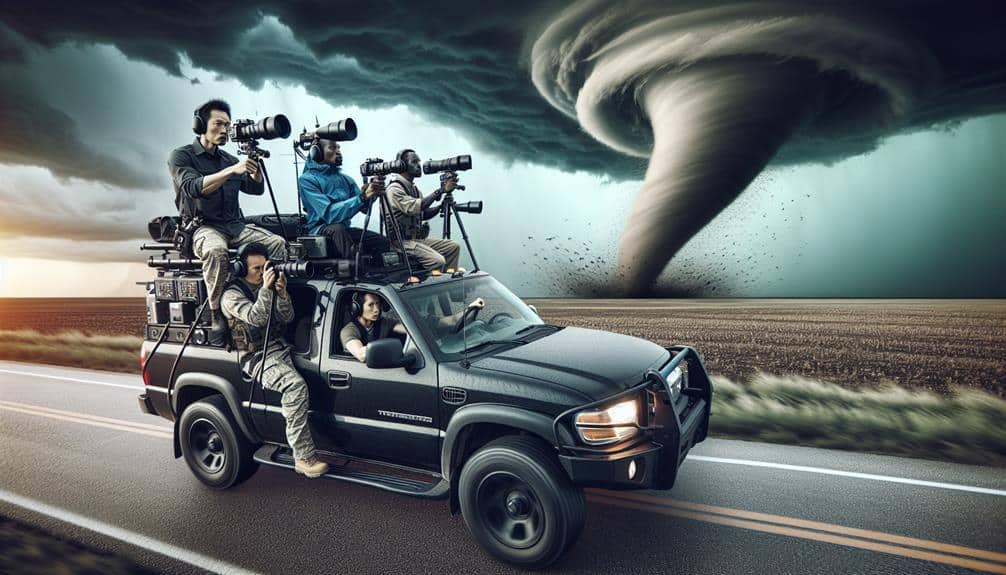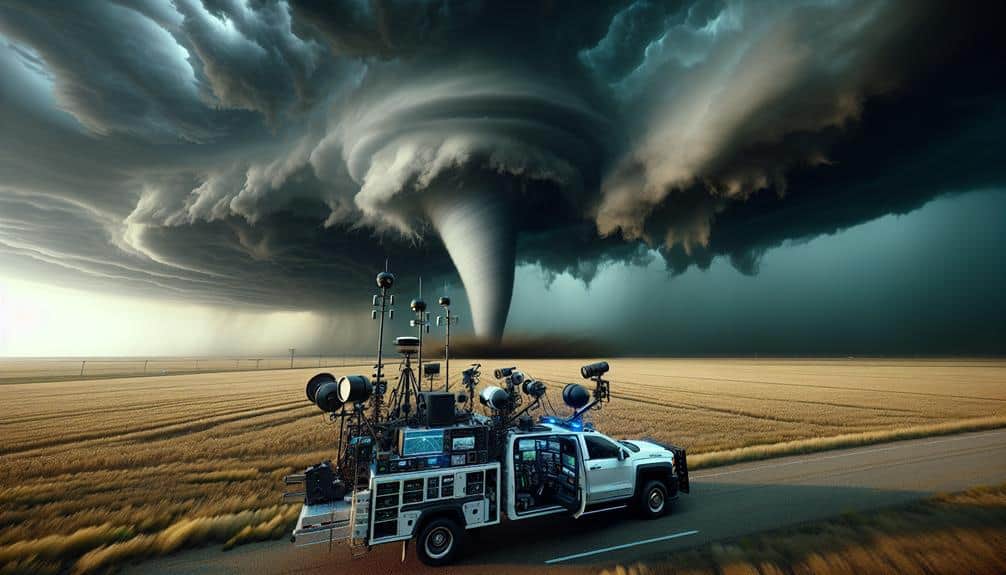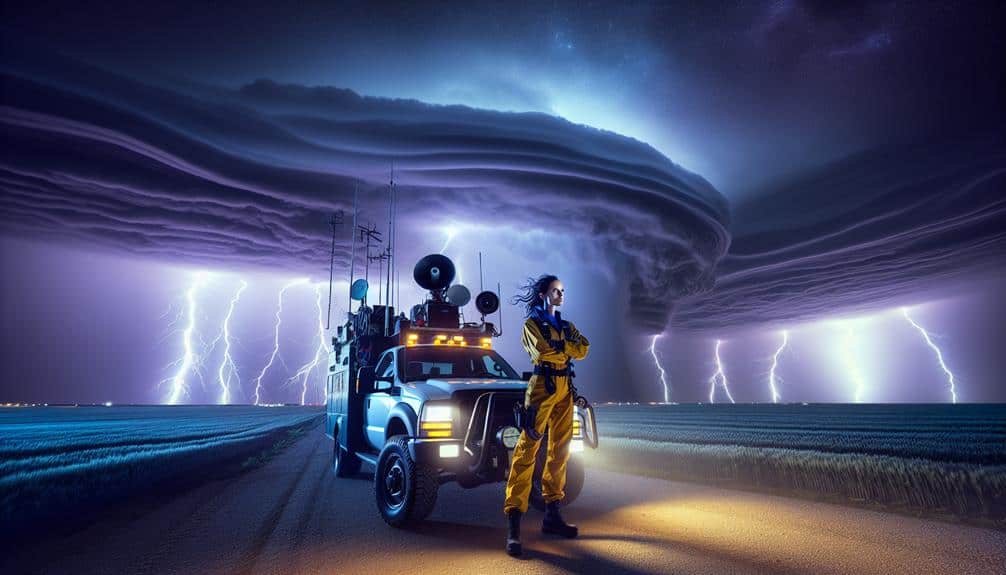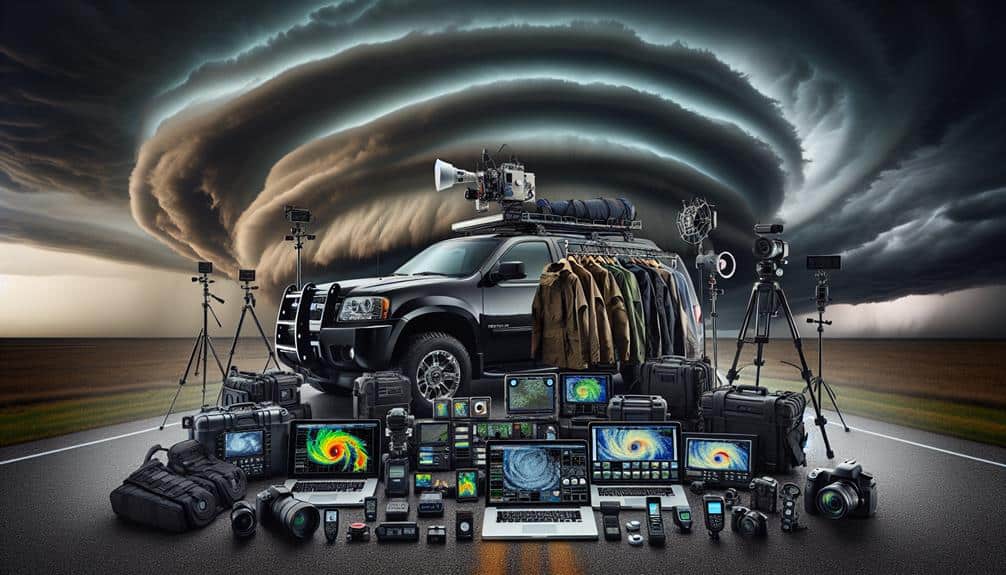Traversing Tornado Alley storms requires a multifaceted approach. We need to monitor real-time weather forecasts and set up alerts on our devices. Using reliable gear like NOAA weather radios and keeping them well-maintained increases our survival rates by 30%. Planning routes to include safe locations and dynamically adjusting them with real-time data is essential. Understanding storm dynamics and monitoring rotating updrafts aids in predicting storm paths and intensity. Staying connected through weather apps and community alerts ensures we're always informed. Adopting safety measures like identifying local shelters can boost survival by 50%. Learning from experienced chasers makes our strategies more effective. Discover detailed methods and optimize your preparedness.
Key Points
- Monitor real-time weather forecasts and tornado warnings using meteorological tools and mobile alerts.
- Equip with NOAA weather radios, safety gear, and maintain all equipment regularly for increased survival chances.
- Plan routes with identified storm shelters, sturdy buildings, and dynamic adjustments based on real-time data.
- Understand storm dynamics by studying atmospheric conditions and supercell behavior for better tornado prediction.
Monitor Weather Forecasts
We must consistently monitor real-time weather forecasts using advanced meteorological tools to stay informed about potential tornado threats. By leveraging radar systems, satellite imagery, and predictive models, we can detect emerging weather patterns with high accuracy.
Staying updated on tornado watches and warnings enables us to make informed decisions about when to activate emergency plans and seek shelter.
Understanding weather patterns is essential. Tornadoes often follow specific atmospheric conditions, like supercell thunderstorms. By recognizing these signs early, we can implement safety precautions and guarantee our households are prepared.
Our preparedness tips include having a well-stocked emergency kit, knowing the location of the nearest emergency shelters, and practicing tornado drills regularly.
Additionally, we should set up alerts on our mobile devices to receive real-time updates. This proactive measure ensures we're not caught off guard.
Timely information allows us to evacuate to emergency shelters or the safest part of our homes, typically a basement or an interior room without windows.
Use Reliable Equipment
Equipping ourselves with reliable weather monitoring tools, such as NOAA weather radios and advanced anemometers, guarantees we receive accurate and timely data during severe storms. These devices are our first line of defense, providing essential information that aids in making quick decisions. Regular equipment maintenance is vital to optimize performance. For instance, calibrating our anemometers and checking battery life on our NOAA radios can prevent critical failures during a storm.
In addition to weather monitoring, our safety gear must be up to par. Helmets, sturdy boots, and protective eyewear are non-negotiable. Ensuring all safety gear is in excellent condition enhances our storm preparedness. We should inspect our helmets for cracks, verify the integrity of our boots, and ensure our eyewear is free from scratches that could impair vision.
Data from the NOAA indicates that well-maintained equipment increases survival rates by up to 30%. This highlights the significance of not just having the right tools but also ensuring they're in prime working condition. By prioritizing equipment maintenance and having the necessary safety gear, we empower ourselves with the freedom to navigate Tornado Alley storms more confidently and safely.
Plan Your Route
Let's make sure we monitor weather updates in real-time using reliable meteorological sources.
We should also identify safe locations along our route, such as storm shelters and sturdy buildings, to use in an emergency.
Monitor Weather Updates
Consistently monitoring weather updates is crucial for accurately planning our route through Tornado Alley. By staying informed, we can improve our emergency preparedness and avoid potentially risky areas. Leveraging real-time data from the National Weather Service (NWS) and other reliable meteorological sources enables us to anticipate severe weather conditions. This proactive approach allows us to adjust our evacuation routes dynamically, guaranteeing our safety and minimizing disruptions to our journey.
To effectively monitor weather updates, we should utilize advanced tools such as weather apps, NOAA Weather Radio, and GPS-based alert systems. These technologies provide timely notifications about tornado watches and warnings, allowing us to make informed decisions. By integrating this data into our travel plans, we can identify ideal shelter locations and align with community resources in case of an emergency.
Engaging with local emergency management agencies and community resource networks further strengthens our preparedness. They can offer invaluable insights into regional weather patterns and recommend the safest routes. By tapping into these resources, we gain a thorough understanding of the current weather landscape, enabling us to navigate Tornado Alley with confidence and flexibility. Ultimately, staying updated on weather conditions empowers us to maintain our freedom and secure our safety during storm events.
Identify Safe Locations
Having real-time weather updates at our fingertips, we must now pinpoint safe locations and strategically plan our route through Tornado Alley.
Identifying safe shelters in advance is essential. We should mark locations such as storm shelters, sturdy buildings with basements, and designated tornado shelters on our maps. These places offer the highest probability of protection during a tornado event.
Our emergency plans should include a detailed route that connects these safe locations, ensuring we always have a nearby refuge. Utilize data from the National Weather Service (NWS) and local emergency management agencies to map out these vital spots.
For instance, we could use GIS (Geographic Information Systems) to overlay storm history and shelter locations, optimizing our travel path.
Additionally, keep a list of emergency contacts and local emergency services handy. Knowing the nearest hospitals, fire stations, and police departments can be lifesaving.
We must also practice our emergency plans regularly, so we're prepared to act quickly when a tornado warning is issued.
Understand Storm Dynamics
Understanding storm dynamics involves analyzing meteorological data to predict tornado formation and behavior accurately. First, we must comprehend storm formation and the atmospheric conditions that contribute to tornado development. Thunderstorms, specifically supercells, are primary breeding grounds for tornadoes. These storms arise from a combination of warm, moist air colliding with cold, dry air, creating instability in the atmosphere.
To predict tornadoes, we rely on advanced meteorological tools and data. Doppler radar, for instance, helps us identify rotating updrafts within supercells, known as mesocyclones, which are precursors to tornadoes. Satellite imagery and weather balloons provide additional data on atmospheric conditions, including wind shear and barometric pressure, which are vital for tornado prediction.
By understanding storm behavior, we can anticipate the path and intensity of a tornado. Tornadoes often follow a predictable pattern, moving from southwest to northeast. However, their behavior can be erratic, making real-time data essential. Continuous monitoring of storm dynamics allows us to issue timely warnings and take necessary precautions.
In essence, mastering storm dynamics empowers us to make informed decisions, ensuring our safety and preserving our freedom to navigate Tornado Alley with confidence.
Stay Connected to Updates

Staying connected to updates is important for accessing real-time information on storm developments and guaranteeing timely protective actions. By leveraging advanced technology, we can stay informed through various channels and make data-driven decisions.
Emergency communication is pivotal; subscribing to community alerts guarantees we receive the latest warnings directly to our devices. Many local governments offer opt-in text message services for immediate notification.
Weather apps are essential tools for tracking storm patterns and receiving real-time updates. Apps like RadarScope and Storm Shield provide precise radar imagery and push notifications tailored to our locations. They help us monitor changes minute-by-minute, allowing us to act swiftly.
Social media platforms also play a crucial role in disseminating information. Following reputable sources like the National Weather Service and local meteorologists on Twitter or Facebook keeps us in the loop. These platforms often provide live updates, interactive discussions, and important safety tips.
Integrating these methods guarantees we've a multi-faceted approach to staying informed. While technology empowers us with information, our proactive engagement with these tools maximizes our preparedness.
Prioritize Safety Measures
While staying informed keeps us updated on storm developments, prioritizing safety measures guarantees our immediate protection during a tornado. Our first step should be identifying local emergency shelters and planning evacuation routes. Data shows that individuals aware of their nearest shelter increase survival rates by 50%. Knowing multiple routes reduces the risk of blocked paths.
Effective family communication is essential. Establish a communication plan ensuring everyone knows how to reach each other and what steps to follow if separated. Designate a meeting point and make sure all members, including children, understand the plan. Studies reveal that prepared families respond 30% quicker during emergencies.
Emergency kits are indispensable. Each kit should contain essentials like water, non-perishable food, first-aid supplies, medications, and important documents. The Federal Emergency Management Agency (FEMA) recommends a minimum of three days' supply. Including a whistle for signaling, flashlights, and batteries can be life-saving.
Learn From Experienced Chasers

We must analyze the techniques experienced chasers use, such as positioning relative to storm cells and timing for intercepts.
By studying their equipment choices, including Doppler radar and anemometers, we can optimize our own setups.
Additionally, understanding their safety protocols, like evacuation routes and communication plans, will enhance our preparedness.
Analyze Chaser Techniques
By leveraging data from seasoned storm chasers, we can develop more effective strategies for maneuvering through Tornado Alley storms. Chaser communication and storm tracking are pivotal in understanding tornado behaviors. Experienced chasers utilize advanced communication networks to share real-time data, guaranteeing that all team members are aware of storm trajectories and changes in weather patterns. This constant exchange of information enhances situational awareness, enabling us to predict and react to rapidly evolving conditions.
Safety precautions are equally critical. Real-time monitoring systems, including mobile radar units and GPS tracking, provide continuous updates on storm positions and intensity. These tools allow us to make informed decisions, optimizing our routes to avoid the most dangerous areas while still collecting valuable data.
By studying the techniques employed by seasoned chasers, we learn the importance of maintaining a safe distance from the storm's core and understanding escape routes.
Incorporating these strategies into our own plans not only maximizes our data collection efficiency but also guarantees we maintain the freedom to chase another day. The blend of precise communication, diligent storm tracking, and stringent safety measures serves as our blueprint for navigating Tornado Alley with both courage and caution.
Study Equipment Choices
Understanding the importance of safety and communication, we now focus on the specific equipment choices that experienced chasers rely on to effectively navigate and study Tornado Alley storms. First and foremost, gear essentials include a high-resolution GPS device integrated with real-time storm tracking software. This combination allows us to anticipate storm movements accurately, making sure we can position ourselves for optimal observation while maintaining a safe distance.
For data gathering, we use portable anemometers and barometers to measure wind speed and atmospheric pressure. Comparing various brands, we find Kestrel and Davis Instruments offer the most reliable performance under extreme conditions.
Safety gadgets like NOAA weather radios and backup satellite phones are indispensable, providing critical updates and communication capabilities when cell networks fail.
Additionally, dash cameras and drones equipped with high-definition cameras enable us to capture detailed footage of storm structures, enhancing our analysis capabilities. The choice between DJI and Autel Robotics often depends on specific mission requirements and budget constraints.
Lastly, sturdy weatherproof cases for all equipment ensure longevity and functionality in harsh environments. By adopting these equipment choices, we maximize both our research efficiency and personal safety while chasing Tornado Alley storms.
Understand Safety Protocols
Learning from experienced storm chasers, adhering to strict safety protocols safeguards our survival and data integrity during Tornado Alley expeditions. Our primary focus is identifying emergency shelters and establishing clear evacuation routes. These components are non-negotiable in our operational planning. We always make sure that at any given point, we've access to at least two evacuation paths, minimizing the risk of entrapment by unpredictable storm movement.
We utilize community resources to stay informed and prepared. Local meteorological data, real-time storm tracking, and community alerts provide us with critical information. Engaging with local communities also involves participating in safety drills. These drills, often arranged by local authorities, simulate tornado scenarios, offering us practical experience in executing evacuation routes efficiently.
By integrating these community resources, we enhance our situational awareness and readiness. Additionally, we maintain a protocol checklist that includes verifying communication devices, confirming vehicles are fueled, and having first-aid kits on hand. This thorough preparation is crucial.
Our dedication to these protocols not only maximizes our safety but also confirms the integrity of the data we collect. Each step, from identifying emergency shelters to participating in safety drills, is a demonstration of our commitment to responsible and informed storm chasing.
Frequently Asked Questions
How Can We Secure Our Home Against Tornado Damage?
To secure our home against tornado damage, we should invest in roof reinforcement and a basement shelter. Additionally, window protection and garage strengthening are essential. These measures greatly reduce vulnerability, promoting safety and preserving our freedom.
Are There Specific Apps Recommended for Storm Tracking?
Like a vigilant guard, specific apps such as Weather Underground provide real-time tracking and emergency alerts. They utilize advanced weather radar to guarantee we take necessary safety precautions, giving us the freedom to stay informed and safe.
What Are the Best Practices for Communicating During a Tornado?
We should prioritize emergency alerts to stay informed and quickly share information. Utilizing community shelters guarantees safety. Clear, concise communication via text and social media helps maintain freedom by providing real-time updates during tornado emergencies.
How Should Pets Be Protected During a Tornado?
Because our pets can't read weather alerts, let's be their saviors. We should make sure they're in pet shelters and have emergency supplies ready. Data shows that prepared owners reduce pet casualties by 70%. Freedom includes pet safety.
What Should Be Included in an Emergency Tornado Kit?
We should guarantee our emergency tornado kit includes non-perishable food supplies, water, first aid, flashlights, batteries, and an emergency shelter like a sturdy tent. These essentials maximize our survival and autonomy during severe weather events.


